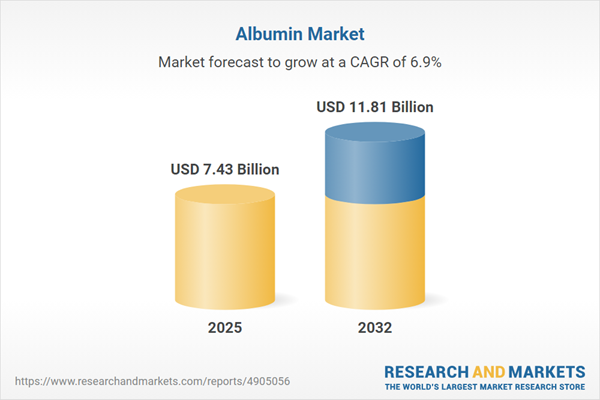Speak directly to the analyst to clarify any post sales queries you may have.
The albumin market is undergoing significant transformation as organizations prioritize regulatory compliance, technology integration, and strategic procurement. Senior decision-makers must stay ahead by adapting supply processes and risk management strategies to support effective, sustainable growth in the evolving biopharmaceutical sector.
Market Snapshot: Albumin Market Size and Growth Trends
The albumin market is projected to reach USD 6.94 billion in 2024, with a compound annual growth rate of 6.86%. This expansion is driven by increasing adoption of albumin across clinical care, diagnostics, and research applications. Suppliers in the market are focusing on enhancing digital procurement and optimizing supply chain processes to align with new compliance expectations. These digital advancements enable organizations to adjust rapidly to emerging regulations and procurement frameworks, improving transparency throughout global operations. Additionally, the adoption of flexible, scalable operational models allows companies to maneuver complex sourcing and regional demands, ensuring resilience and adaptability in business continuity planning.
Scope & Segmentation of the Albumin Market
Comprehensive segmentation gives organizations a practical framework for targeting procurement, managing risk, and achieving tailored compliance in the albumin supply chain. Segment-based insights enable executives to refine operational approaches and align strategies with end-user requirements across multiple domains.
- Product Type: Bovine serum albumin, human serum albumin, and recombinant albumin each address specific clinical functions, regulatory requirements, and procurement processes.
- Formulation: Both liquid and lyophilized albumin formulations provide flexibility for diverse clinical and research settings, supporting varying storage and logistics needs.
- Grade: Diagnostic, pharmaceutical, and research grades cater to differing quality, safety, and operational standards in end-use environments.
- Application: Albumin is used in biosimilar development, drug delivery systems, laboratory research, and diagnostics, shaping innovation priorities and technical selection criteria for buyers.
- End User: Diagnostics centers, hospitals, clinics, pharmaceutical manufacturers, and research organizations have unique procurement expectations, influencing product cycles and supplier relationships.
- Sales Channel: Direct sales, pharmacy distribution, digital procurement, and industry partnerships support varied sourcing models and agile responses to market shifts.
- Region: Key territories include the Americas, Europe, Middle East & Africa, and Asia-Pacific, each with distinct regulatory and technology adoption factors impacting compliance and risk management.
- Technology Focus: Recombinant protein production, single-use bioreactor systems, continuous manufacturing, and advanced analytics contribute to improvements in production efficiency, traceability, and oversight.
Suppliers such as Grifols S.A., CSL Limited, Octapharma AG, and Baxter International Inc. stand out for their flexible, region-specific sourcing approaches, tailored to meet regulatory and operational requirements in diverse markets.
Key Takeaways for Senior Decision-Makers
- Ensuring a resilient supply chain and robust risk mitigation is paramount for organizations operating in unpredictable healthcare and biopharmaceutical environments.
- Engineered recombinant processes and advanced analytics streamline procurement and help maintain clearly defined compliance processes aligned with sector demands.
- Forging partnerships with technology vendors sustains product pipelines and drives responsiveness to evolving industry requirements and procurement models.
- Implementing single-use bioreactor systems supports rapid adaptation to regulatory change, increasing operational agility and improving oversight.
- Upgrading digital infrastructure, especially in the Asia-Pacific region, empowers more agile procurement and distribution, fueling growth where demand is highest.
- Digital sourcing platforms and real-time data analytics enable decision-makers to monitor conditions proactively and manage risk through transparent supply visibility.
Tariff Impact: Changes in US Albumin Import Frameworks
Recent changes to U.S. tariffs prompt pharmaceutical organizations to bolster domestic manufacturing and engage more deeply with local suppliers. This shift drives the need for adaptive cost strategies and comprehensive risk management to stay compliant under a dynamic global trade environment.
Methodology & Data Sources
This analysis is founded on in-depth secondary research from leading industry and regulatory sources, further strengthened by direct interviews with procurement professionals. A robust data triangulation process ensures accuracy and relevance for executive planning.
Why This Report Matters
- Aligns compliance programs with organizational strategies during regulatory and technological change.
- Supports supplier and resource selection, maximizing procurement outcomes and deepening strategic partnerships in transforming sourcing environments.
- Drives integration of procurement and research teams to build resilient risk management and secure continuity in complex market conditions.
Conclusion
Sustained success in the albumin market relies on supply chain agility, strong supplier relationships, and a continuous commitment to compliance and operational innovation.
Additional Product Information:
- Purchase of this report includes 1 year online access with quarterly updates.
- This report can be updated on request. Please contact our Customer Experience team using the Ask a Question widget on our website.
Table of Contents
3. Executive Summary
4. Market Overview
7. Cumulative Impact of Artificial Intelligence 2025
Companies Mentioned
The companies profiled in this Albumin market report include:- Grifols, S.A.
- CSL Limited
- Octapharma AG
- Baxter International Inc.
- LFB S.A.
- Kedrion S.p.A.
- Biotest AG
- Shanghai RAAS Blood Products Co., Ltd.
- Green Cross Corporation
- Bio Products Laboratory Limited
Table Information
| Report Attribute | Details |
|---|---|
| No. of Pages | 193 |
| Published | October 2025 |
| Forecast Period | 2025 - 2032 |
| Estimated Market Value ( USD | $ 7.43 Billion |
| Forecasted Market Value ( USD | $ 11.81 Billion |
| Compound Annual Growth Rate | 6.8% |
| Regions Covered | Global |
| No. of Companies Mentioned | 11 |









